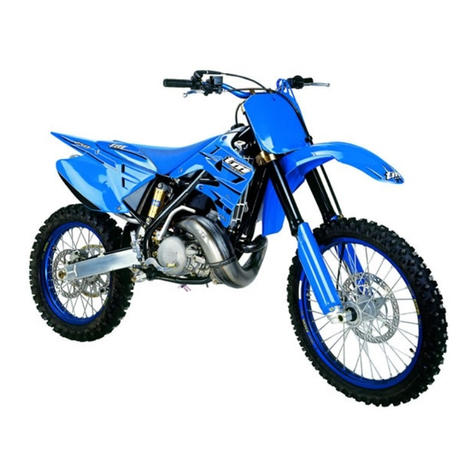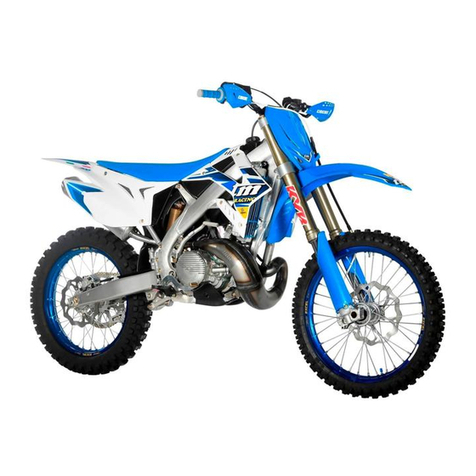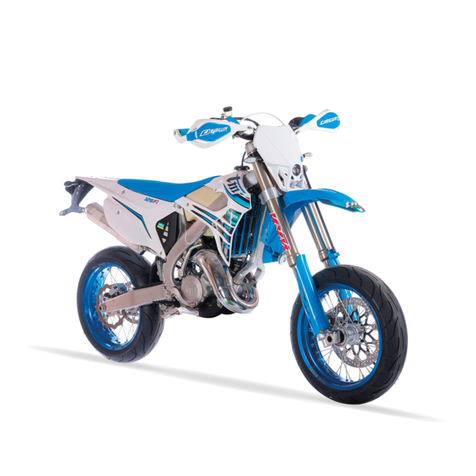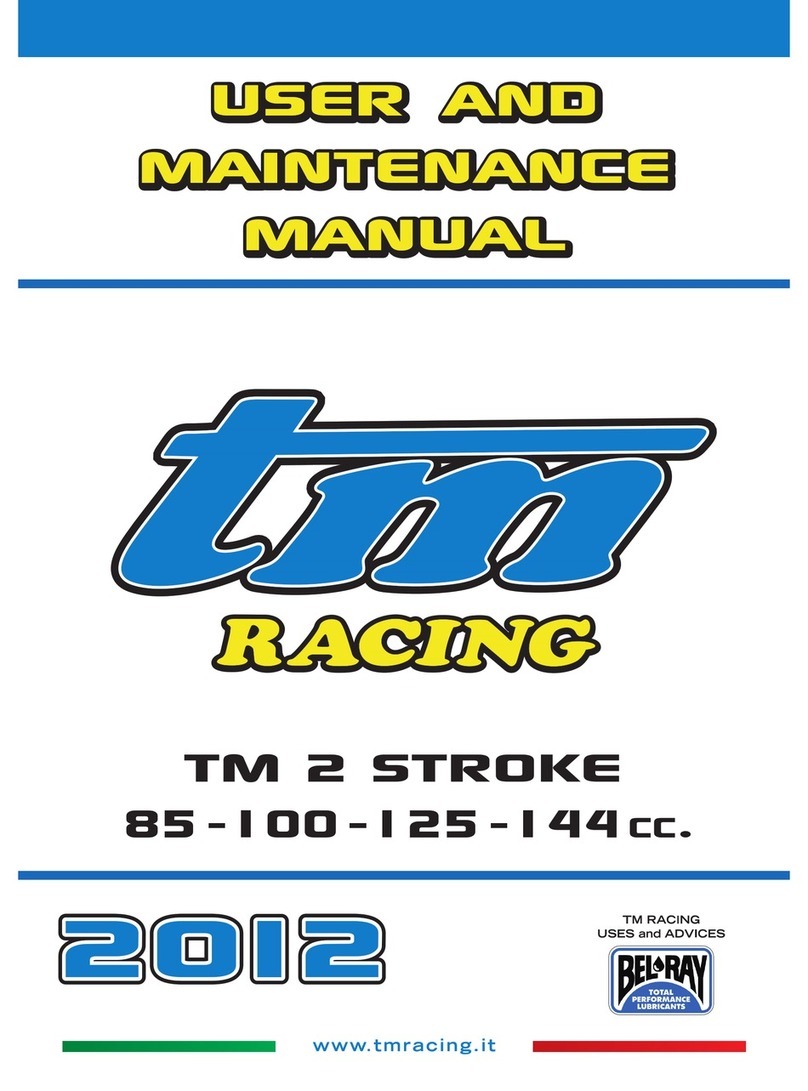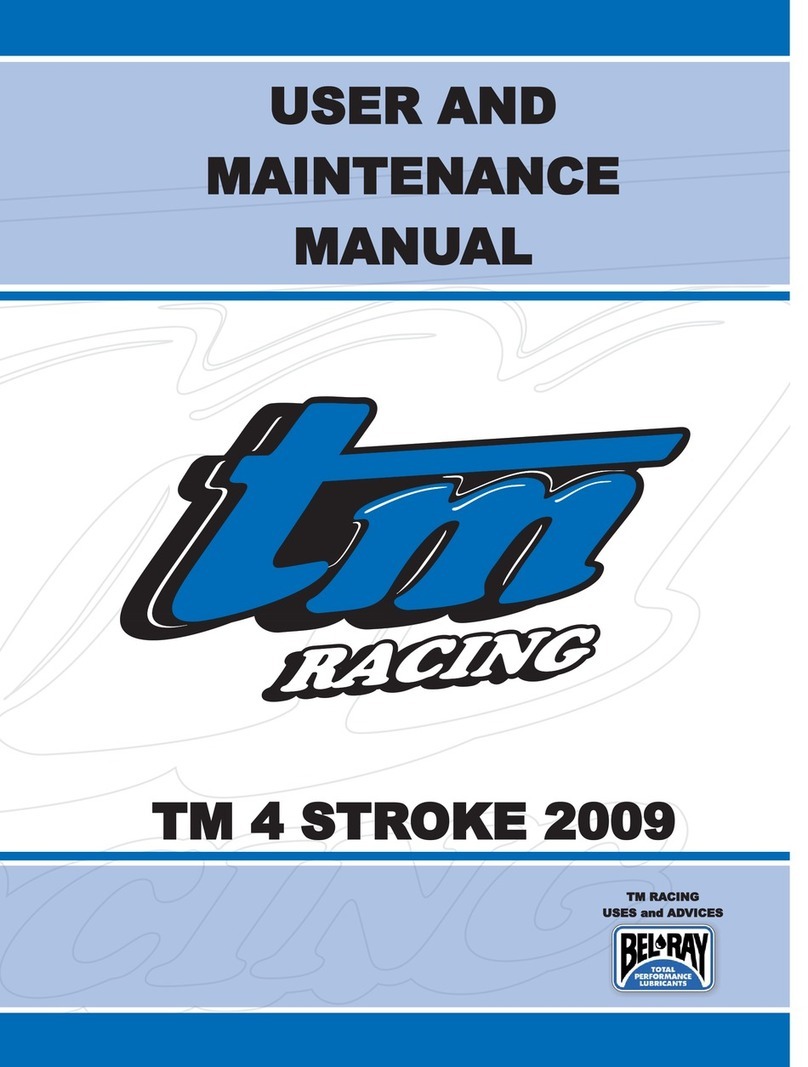ENGLISH
ENGLISH
6
INDEXINDEX
INDEXINDEX
INDEX
Page
POSITION OF SERIAL NUMBERS..................................................... 7
Frame number.................................................................................... 8
Engine number.................................................................................... 8
OPERATING CONTROLS.....................................................................9
Clutch lever.........................................................................................10
Manual decompressor lever............................................................... 10
Front brake lever................................................................................ 10
Control lights.......................................................................................10
Electronic tachometer ....................................................................... 11
Function selection and reset.............................................................. 11
Programming the electronic tachometer............................................. 11
Programming the clock....................................................................... 12
Setting the distance travelled............................................................. 12
Engine stop switch (MX/SMX).............................................................12
Combinationswitch (END/SMR/SMM)................................................ 12
Start command and emergency stop
(END/MXE.S./SMXE.S./SMR/SMM) ..................................................... 13
Fuel fill cap......................................................................................... 13
Fuel tap.............................................................................................. 13
Throttle command (cold starter)......................................................... 14
“By-Pass” command (warm starter)...................................................14
Idle speed adjustment command.........................................................14
Gear shift pedal .............................................................................. 15
Kickstart pedal................................................................................... 15
Brake pedal ...................................................................................... 15
Side stand.......................................................................................... 15
Fixing for off-the-road journeys.........................................................16
Ignition switch.................................................................................... 16
Fork adjustment in compression........................................................ 16
Fork adjustment in extension..............................................................17
Damper adjustment in compression................................................... 17
Damper adjustment in extension........................................................ 18
Steering lock ..................................................................................... 19
ADVICEANDGENERALRECOMMENDATIONSFOR
COMMISSIONING THE MOTORCYCLE .......................................... 21
Indications for the first start-up..........................................................22
Running in instructions....................................................................... 22
INSTRUCTIONSFORUSE...................................................................23
Pre-ride control.................................................................................. 24
Engine ignition when cold...................................................................25
Engine ignition when warm ............................................................... 25
If engine is “flooded”.......................................................................... 26
Departure............................................................................................26
Changing gear, accelerating, slowing down.......................................26
Braking................................................................................................28
Stoping and parking ........................................................................ 28
Petrol.................................................................................................. 29
LUBRICATIONAND MAINTENANCE PROGRAMME ...................... 31
FRAMEANDENGINE MAINTENANCE ............................................. 37
Control of steering bearings and play adjustment...............................38
Telescopic fork vent screws............................................................. 39
Cleaning of telescopic fork dust scraper........................................... 39
Basic calibration of the chassis on the basis of pilot weight .......... 39
Damper calibration and spring control................................................40
Establishment of damper static lowering........................................... 40
Establishment of damper lowering in running order........................... 40
Control of telescopic fork basic calibration........................................ 41
Variation of telescopic fork pre-load.................................................. 41
Replacement of fork springs...............................................................41
Variation of damper spring pre-load ..................................................42
Rear suspension mechanical linkage................................................. 42
Page
Control chain tension......................................................................... 43
Correction of chain tension (all except SMM) ................................. 43
Correction of chain tension (SMM) ................................................... 44
Chain maintenance............................................................................. 44
Chain wear.........................................................................................45
Basic indications for TM disc brakes................................................. 45
Free play adjustment of the front brake lever......... ...................... 46
Control front brake fluid......................................................................47
Top-up front brake fluid...................................................................... 47
Control front brake pads.....................................................................47
Replacement of front brake pads.......................................................48
Modification of rear brake pedal basic position..................................49
Control rear brake fluid level.............................................................. 49
Top-up rear brake fluid....................................................................... 49
Control rear brake pads......................................................................50
Replacement of rear brake pads........................................................50
Disassembly and assembly of front wheel........................................50
Disassembly and assembly of rear wheel (all except SMM) ......... 51
Disassembly and assembly of rear wheel (SMM)..............................52
Control of spoke tension.....................................................................52
Tyres, tyre pressure.......................................................................... 53
Control/adjustment of magnetic sensor distance................................53
Battery(all models with E.S.) .......................................................... 53
Battery charger...................................................................................54
Recharge fuse (all models with E.S.) ............................................. 55
Services fuse (all models with lights)............................................... 55
Replacement of headlight / position light bulb.................................... 55
Replacement of headlight / position light bulb (with cyclops).............56
Replacement of rear light bulb
positionlight/stop light/numberplate light(END/SMR/SMM) ................56
Replacement of indicator bulb............................................................ 56
Cooling................................................................................................57
Control coolant level........................................................................... 58
Unloading, filling and bleeding of cooling system................................58
Replacement of exhaust silencer filling material.................................58
Cleaning the air filter........................................................................... 59
Control of hand decompressor adjustment........................................ 59
Adjustment of throttle cable command............................................... 60
Adjustment of clutch lever basic position.......................................... 60
Control hydraulic clutch oil level......................................................... 60
Bleeding of hydraulic clutch................................................................60
Carburetor - Adjustment of idle speed............................................... 61
Basic indications regarding wear of the carburetor...........................61
Control fuel level (float height)........................................................... 62
Emptying of carburetor tank............................................................... 62
Oil circuit .................................................................................. 62
Control engine oil level........................................................................63
Engineoil ........................................................................................ 63
Change engine oil ............................................................................ 63
TROUBLESHOOTING......................................................................... 66
CLEANING..........................................................................................68
PRECAUTIONSFOR WINTER USE.................................................... 68
PRESERVATION................................................................................. 68
Start-up after seasonal pause........................................................... 68
TECHNICAL DATA - ENGINE........................................................ 69/70
CARBURETORSETTINGS..................................................................71
ENGINECOUPLINGTORQUES.......................................................... 72
CYCLE PART TECHNICAL DATA .................................................73-74
ALPHABETICAL INDEX......................................................................75
WIRING DIAGRAM................................................................ appendix
INDEXINDEX
INDEXINDEX
INDEX
